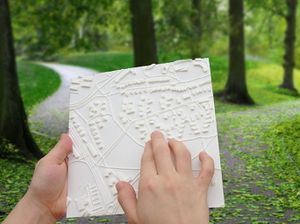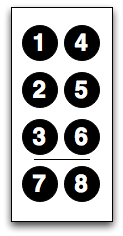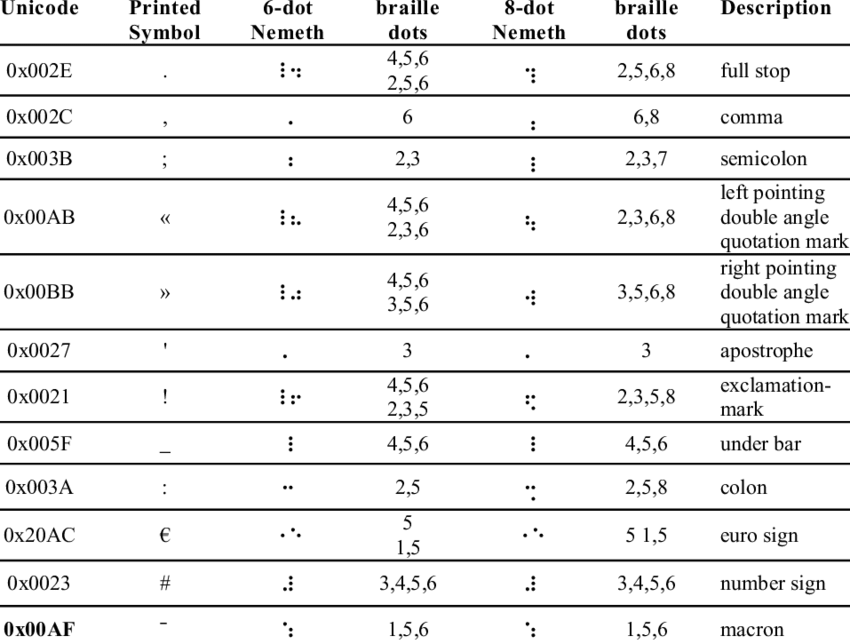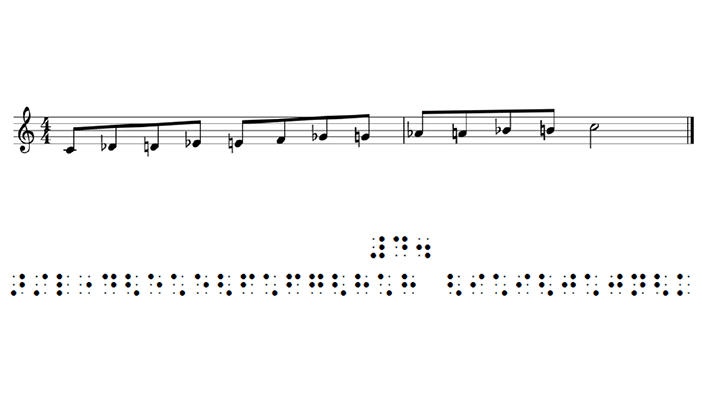We mentioned in the definition of braille that braille is a universal method of reading by touch and that it can be adapted to any of the world’s languages. We also indicated that it is made up of different formations of raised dots – the most of which are six and the least one – within rectangular cells. Due to the limited number of possible configurations within a single cell, the need for multiple reading and writing styles in braille appeared according to the type of content. For example, there is a style for regular literary writing, a style for mathematics and science, another for music, and so on.
Braille is a fixed font, meaning that dots cannot be enlarged or reduced in size as is the case with regular printing. This means that books printed in braille are bulky and heavy. For example, the entire Holy Quran was printed in six large volumes. As for the Harry Potter series, the American Printing House for the Blind converted it into braille in about 56 volumes. Hence, the need to invent methods in which the written content space is somewhat reduced had emerged.
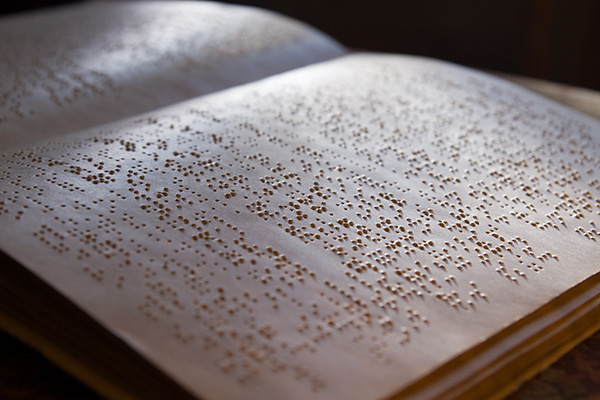
The most important patterns or grades of braille writing and reading are:
Braille Grade 1
It is also called alphabetical braille, literal braille, or simple braille, in which each letter and symbol is represented in a separate cell. Children and beginners usually start learning literal braille first, which is used for printing children’s books, and for printing on posters, banners, and other commonly used items.
This pattern requires more space on the paper or the braille display, and thus, takes longer for the blind to read it, which is a disadvantage. However, it is characterized by being easy to learn, easy to read, and used commonly.
Braille Grade 2
It is also referred to as braille with acronyms, or literary braille, in which some common words or linguistic structures in one or more cells are shortened, to reduce the writing space and save effort. This pattern is typically used for printing advanced books, curricula, for older students, and other literary text content. Regarding the Arabic language, there are more than 250 different acronyms. The advanced braille student learns most of them by memorization and continuous practice. Some common words that have acronyms include “أو” (or), “بل” (but), “تلك” (that), “ثم” (then), “جدًّا” (much), “هذا” (this), “إلى” (to), and so on, or for some frequently used combinations, such as “ال” (for definition), the suffix “ون” (for the plural), and others.
Example
To write the sentence “ماذا يقول؟” (What is he saying?) in simple braille, it will need 17 cells, so that each letter, space, and punctuation sign is in a separate cell, and it would be written like this: ⠍⠁⠀⠓⠮⠁⠀⠁⠇⠮ ⠊⠀⠊⠟⠺⠇⠦
As for the abbreviations/ acronyms, the number of cells will be reduced to 11, due to the shortening of some letters of that sentence in fewer cells, so that it would be written like: ⠐⠏⠀⠐⠓⠀⠐⠉⠀⠸⠊⠦
This grade has the advantage that it takes less space on the paper or the braille display, and thus, shorter time to read it, especially by braille experts. But the disadvantage of this grade is that it needs some time to be learned and practiced, and it is not enough for the blind to know the common abbreviations/ acronyms for using this grade electronically.
8-Dot Braille
With the advancement of technology and braille entering the computer world, especially with the emergence of electronic braille displays, the need for a larger braille cell appeared to accommodate the many computer signs. Therefore, the 8-dot braille was created, and it is suitable for use with electronic braille devices and printers that support the 8-dot cell, instead of the traditional 6-dot cell. This cell allows 255 different shapes to be written as opposed to those sixty-four as in the 6-dot cell, and it helps provide a greater opportunity to find equivalents for computer signs such as object shapes, programming symbols, complex mathematics, and other technical needs. It is noteworthy that our website presents the first actual attempt to create an integrated 8-dot Arabic Braille table, the details of which can be viewed by visiting its section of the website.
Braille for Science and Mathematics
There are signs for science and mathematics writing, commonly used in complex technical content, such as chemical equations, computational issues, fractions, engineering processes, physics, and the like. The reader is usually aware that they are reading accurate technical content, and that they have received appropriate training in reading these signs. For example, there is a collection of mathematics and science signs for Arabic Braille script, and there is a global method of writing mathematics and science known as the Nemeth Code.
The use of the Nemeth Code to represent science and mathematics symbols in braille is more efficient because it contains all branches of mathematics, including arithmetic, algebra, geometry, trigonometry, functional analysis, normal and vector calculation, calculus, geography, accounting, and more. Our website provides visitors with a simple guide to start learning this grade.
Braille Grade for Music
This grade uses combinations of the same 6-dots cell — such as the literary braille method — to represent the degree and rhythm of each tone so that the upper rows represent the tone degree and use the lower row to represent the rhythm. Usually, the blind music reader needs to remember what they read before performing on their instrument because unlike writing a printed musical note, they must read the symbols from left to right, one by one, i.e., they do not have the feature of a quick examination of the note in a graphic form, and it is difficult for them to read with one hand and play with the other hand at the same time.
There is also the problem of space in music writing, a single musical sentence may take up a lot of space in braille, so braille’s grade of music script offers a set of tags and symbols that are used to refer to a repetition of a sentence, part of a sentence, or a tone, etc. There is also a group of notations that are written in two or more cells due to the need to represent more musical symbols.
International Phonetic Alphabet
The International Phonetic Alphabet (IPA) is an attempt to represent, write, and arrange all sounds in all languages in an alphabet based primarily on Latin letters and some symbols borrowed from the Roman and Greek alphabet, and is useful for those who want to recognize the sounds of languages as accurately as singers who want to learn foreign languages. In 1934, an initiative was launched to try to represent that alphabet in braille and was recently adopted by the International Council of English Braille. It is a complementary grade that can be used and written with other braille signs in its own context. More information on how to write it and get a list of its symbols are provided on this website.
Foreign Languages
If you are blind and want to learn to read and write in a new language or are in the process of learning it, don’t worry, braille is widespread in all countries, so there is a braille style for each language. The 6-dots braille cell is configured and adapted to accommodate each language with its alphabet, symbols, and all its other requirements. The Arabic language, for example, has symbols for the alphabet, the “Hamza” (ء), the diacritics, and the punctuation signs, etc.
This indicates that the same symbol in Arabic may mean a different symbol in English, Chinese, etc., so the reader should be informed in advance of the braille text language they are reading, but if they don’t already know the language, they won’t have a hard time knowing that the text is in a foreign language and it may be easy to know the language if they can read and write. If blind people want to learn English, for example, all they have to do is get the material printed in braille, and then they can participate in the learning process normally with their peers who read printed materials.
It is worth mentioning that many languages contain braille grade 1, braille grade 2 (Braille with abbreviations/acronyms), and 8-dot braille of its own.
Note: A 2013 book, jointly issued by the Perkins Institute for the Blind, The Library of Congress for People with Disabilities Services, and the International Council of English Braille, has collected braille grades for some 113 languages around the world, accessible via this link.
Example
If, for example, we want to write in Arabic Braille Grade 1 the Arabic sentence “برايل هو طريق المعرفة” (Braille is the path to literacy), it will be like: ⠃⠗⠁⠊⠇⠀⠓⠺⠀⠾⠗⠊⠟⠀⠁⠇⠍⠷⠗⠋⠡
In English, if we want to write a similar sentence: “Braille is the path to literacy”, it is written like this: ⠃⠗⠁⠊⠇⠇⠑⠀⠊⠎⠀⠞⠓⠑⠀⠏⠁⠞⠓⠀⠞⠕⠀⠇⠊⠞⠑⠗⠁⠉⠽
Note: How braille is similar in writing in both languages. The Arabic letter “ب” (B) is similar to the English letter “B” in the composition of its dots, the letter “ر” resembles “R”, and the letter “أ” is similar to “A”, and so on. Of course, not all letters are the same, a person needs to learn the signs for the letters of any language to be able to read them.
Tangible Images
Using braille goes beyond just representing letters, symbols, and punctuation signs. There are ways to create tangible graphics that can be used with blind students – especially in elementary school – and others to enhance their understanding of geometric shapes, maps, and more. You can create standout maps, diagrams, shapes, solids, infographics, and other physical images, but this is not as easy as producing textual content with braille. There are many considerations involved in this matter, the most important of which is the tool used to produce these images, as some of them may be somewhat expensive. The second is the extent to which the blind person needs this tangible drawing, and whether it can be dispensed with a textual equivalent. Finally, the degree of the person’s benefit from it, its suitability for the user’s environment, and the instructions used in creating such a tangible drawing.
